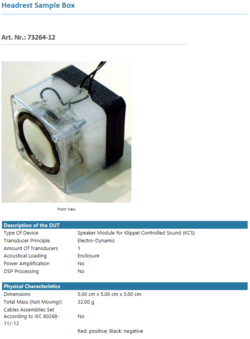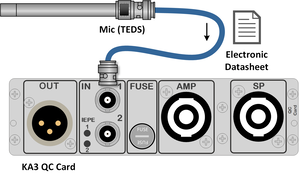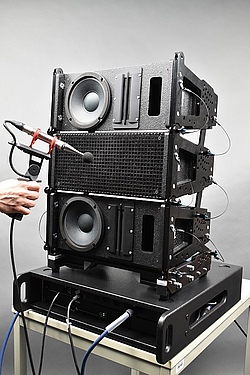What’s New in dB-Lab 212.332 – QC 7.3
New: Minor dB-Lab Update
A minor software update is now available for both R&D and QC applications of the KLIPPEL Analyzer System. It is free of charge for any users of dB-Lab major version 212 or QC 7. For more information of the minor update, see our updated version of the What's New briefing sheet - Click here for the English Version | Chinese Version
Main features of this updates are:
Documentation module (DOC) – New utility module for use in dB-Lab
The new DOC module for any dB-Lab operation (R&D or QC). The primary goal is documenting measurements in a stand-ard-conform way (IEC 60286) as an easy process. Most conditions and properties to be stated by the manufacturer are directly available and simply need to be filled out. Each manufacturer can customize those documentations, and select which properties are im-portant for the particular measurement. Storing such configurations as operation templates simplifies the most often neglected, but valuable process of documentation. Thus, besides actual measurement data, the description of the device under test and test conditions are displayed. Consequently, communication with suppliers and customers becomes simpler and more meaningful. Also, instructions and guidelines can be stored and displayed to ease the operator’s work. Datasheets or any other supplementary documents or pictures can be stored in the measurement database together with test results. The DOC module is free of charge and available without license.

TEDS integration for microphones
TEDS has been made available for any KA3 having QC-Card(s) in-stalled. TEDS is an electronic datasheet (IEEE 1451) storing sensi-tivity and meta data such as manufacturer and sensor type information. Any data stored in TEDS compatible microphones can be converted easily into KLIPPEL sensor files. This information can be used with any input, even those which do not support TEDS, such as Klippel Analyzer (KA3) Laser card, Distortion Analyzer (DA2) and Production Analyzer (PA) hardware as well as 3rd party audio interfaces or soundcards. For any QC test using the QC card, the connected microphones are checked at login and the TEDS data are used for measurement whereas unknown sensors are detected and rejected. Full traceability is provided, proper calibration is ensured, and measurement problems due to non-confirmed sensors are avoided.

QC Stand-alone Software
Klippel QC Stand-alone Software is designed to work with 3rd party audio interfaces or to measure PC-connected audio devices (such as USB audio or smart speakers). In particular, it works smoothly with digital amplifiers or devices that can measure and stream cur-rent and / or voltage via audio-over-IP (e.g., Dante®). QC 7.3 version now supports the calibration of such devices. Sensor files are available for selected amplifiers.
Setting explanations and application example for the KLIPPEL QC Stand-alone Software
The Tech-Note TN17 - Setting up DANTE & Powersoft Mezzo for QC Stand-alone Software explains the use of those amplifiers using Powersoft installed amplifiers series as an example. Any impedance-based measurement task of the QC software such as Impedance Task (IMP), Motor and Suspension Check (MSC), Balanced Armature Check (BAC), Multitone Distortion (MTD) and others support 3rd party streaming V/I amplifiers.
Application Note AN 79b Efficient, Mobile Quality Assurance of PA Speakersillustrates the use of those amplifiers and describes a low-effort solution for reliable incoming quality checks of professional audio equipment. The complete hardware can be stored in a compact 2 height, 19” rack. Please contact Klippel support team for more information.

KLIPPEL QC System
KLIPPEL QC now provides channel aggregation for multiple microphone measurements. A typical use case for aggregating data is testing microphone arrays, measuring spatially averaged sound field characteristics. De-pending on the particular result parameter, this aggregation can be a power average (e.g., magnitude of SPL frequency response), or the overall maximum value (e.g., impulsive distortion “Rub&Buzz”) of all channels.
Aggregation of multi-channel microphone data is the measurement data acquired in cars to assess the sound field for each passenger using a microphone array. Related to this feature, there is a running activity by the AES Technical Committee on Automotive Audio. A white paper In-car Acoustic Measurements shall suggest a standardized assessment and comparison of acoustic properties in cars. Klippel contributes to this activity and supports proposed measurements.
For more information of the minor update, see our updated version of the What's New briefing sheet - Click here for the English Version | Chinese Version
Or contact our Sales and Support Team via e-mail sales(at)klippel(dot)de | rnd-support(at)klippel(dot)de | qc-support(at)klippel(dot)de
